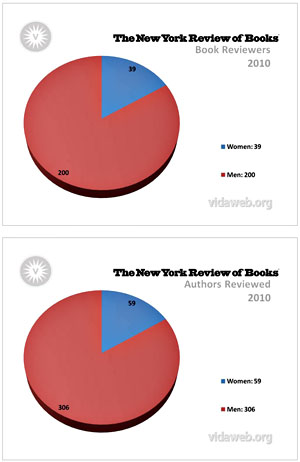VIDA informed us last week that most major magazines publish a lot more book reviews by men than by women, as well as a lot more reviews of books by men than by women. Why? Ruth  Franklin tallied up the books published by a sample of major publishers and concluded that the problem probably isn’t with the magazines themselves:
Franklin tallied up the books published by a sample of major publishers and concluded that the problem probably isn’t with the magazines themselves:
Only one of the houses we investigated—the boutique Penguin imprint Riverhead—came close to parity, with 55 percent of its books by men and 45 percent by women. Random House came in second, with 37 percent by women. It was downhill from there, with three publishers scoring around 30 percent—Norton, Little Brown, and Harper—and the rest 25 percent and below.
….I speculated that independents—more iconoclastic, publishing more work in translation, and perhaps less focused on the bottom line—would turn out to be more equitable than the big commercial houses. Boy, was I wrong….Graywolf, with 25 percent female authors, was our highest-scoring independent….Melville House came in at 20 percent….Verso was second-to-last at 11 percent.
….Now we can better understand why fewer books by women than men are getting reviewed. In fact, these numbers we found show that the magazines are reviewing female authors in something close to the proportion of books by women published each year. The question now becomes why more books by women are not getting published.
I remember a few years ago reading a piece by an op-ed page editor — Gail Collins? — saying that her submissions ran something like 10:1 in favor of men. She wanted to publish more stuff by women, she said, but just didn’t have much to choose from. In the case of op-eds, one obvious answer is simply to try harder: solicit pieces from good women and try to improve the balance that way. This has a good chance of success, since op-eds only take a few hours to write. But I don’t know enough about the industry to know if that would work in book publishing. Books, after all, need a lot more than a couple of phone calls to solicit. Any publishing pros care to weigh in on this?

















